Vegetation Growth Status and Topographic Effects in the Pisha Sandstone Area of China
Abstract
:1. Introduction
2. Study Area and Data
2.1. Study Area
2.2. Data
3. Methodologies
3.1. Fractional Vegetation Coverage
3.2. Trend Analysis
3.3. Topographic Effects
4. Results
4.1. Variations in FVC
4.1.1. Temporal Variations in FVC
4.1.2. Spatial Variations of FVC
4.2. Variations in Topographic Effects
4.2.1. Elevation Effects
4.2.2. Slope Effects
4.2.3. Aspect Effects
5. Discussion
5.1. Natural Factors
5.2. Human Factors
6. Conclusions
Author Contributions
Funding
Acknowledgments
Conflicts of Interest
References
- Bai, L.; Wang, N.; Jiao, J.; Chen, Y.; Tang, B.; Wang, H.; Chen, Y.; Yan, X.; Wang, Z. Soil erosion and sediment interception by check dams in a watershed for an extreme rainstorm on the Loess Plateau, China. Int. J. Sediment Res. 2020. [Google Scholar] [CrossRef]
- Peng, X.; Dai, Q.; Ding, G.; Shi, D.; Li, C. Impact of vegetation restoration on soil properties in near-surface fissures located in karst rocky desertification regions. Soil Tillage Res. 2020, 200, 104620. [Google Scholar] [CrossRef]
- Riitters, K.; Wickham, J.D.; Wade, T.G. Evaluating anthropogenic risk of grassland and forest habitat degradation using land-cover data. Landsc. Online 2009, 13, 1–14. [Google Scholar] [CrossRef]
- Guda, A.M.; Elhemaly, I.; Aal, E.A.; Odah, H.; Appel, E.; Kammar, A.M.E.; Khatita, A.M.A.; Salem, H.S.A.; Awad, A. Suitability of magnetic proxies to reflect complex anthropogenic spatial and historical soil heavy metal pollution in the southeast Nile delta. Catena 2020, 191, 104552. [Google Scholar] [CrossRef]
- Yang, F.; Cao, M.; Li, H.; Wang, X.; Bi, C. Simulation of sediment retention effects of the single seabuckthorn flexible dam in the Pisha Sandstone area. Ecol. Eng. 2013, 52, 228–237. [Google Scholar] [CrossRef]
- Yang, F.; Bi, C.; Cao, M.; Li, H.; Wang, X.; Wu, W. Simulation of sediment retention effects of the double seabuckthorn plant flexible dams in the Pisha Sandstone area of China. Ecol. Eng. 2014, 71, 21–31. [Google Scholar] [CrossRef]
- Xi, J. Speech at the symposium on ecological protection and high-quality development in the Yellow River Basin. Qiushi 2019, 32, 1–5. (In Chinese) [Google Scholar]
- Salim, H.A.; Xiaoling, C.; Jianya, G. Analysis of Sudan vegetation dynamics using NOAA-AVHRR NDVI data from 1982-1993. Asian J. Earth Sci. 2008, 2, 20–34. [Google Scholar] [CrossRef]
- Achard, F.; Eva, H.; Stibig, H.; Mayaux, P.; Gallego, J.; Richards, T.; Malingreau, J. Determination of Deforestation Rates of the World’s Humid Tropical Forests. Science 2002, 297, 999–1002. [Google Scholar] [CrossRef] [Green Version]
- Parmesan, C.; Yohe, G.W. A globally coherent fingerprint of climate change impacts across natural systems. Nature 2003, 421, 37–42. [Google Scholar] [CrossRef]
- Weiss, J.L.; Gutzler, D.S.; Coonrod, J.E.A.; Dahm, C.N. Long-term vegetation monitoring with NDVI in a diverse semi-arid setting, central New Mexico, USA. J. Arid Environ. 2004, 58, 249–272. [Google Scholar] [CrossRef]
- Al-Bakri, J.T.; Taylor, J.C. Application of NOAA AVHRR for monitoring vegetation conditions and biomass in Jordan. J. Arid Environ. 2003, 54, 579–593. [Google Scholar] [CrossRef] [Green Version]
- Dutta, D.; Das, P.K.; Paul, S.; Sharma, J.R.; Dadhwal, V.K. Assessment of ecological disturbance in the mangrove forest of Sundarbans caused by cyclones using MODIS time-series data (2001–2011). Nat. Hazards 2015, 79, 775–790. [Google Scholar] [CrossRef]
- Otto, M.; Hopfner, C.; Curio, J.; Maussion, F.; Scherer, D. Assessing vegetation response to precipitation in northwest Morocco during the last decade: An application of MODIS NDVI and high resolution reanalysis data. Theor. Appl. Climatol. 2016, 123, 23–41. [Google Scholar] [CrossRef]
- Huete, A.; Didan, K.; Miura, T.; Rodriguez, E.P.; Gao, X.; Ferreira, L.G. Overview of the radiometric and biophysical performance of the MODIS vegetation indices. Remote Sens. Environ. 2002, 83, 195–213. [Google Scholar] [CrossRef]
- Huete, A.; Liu, H.Q.; Batchily, K.; Van Leeuwen, W.J.D. A comparison of vegetation indices over a global set of TM images for EOS-MODIS. Remote Sens. Environ. 1997, 59, 440–451. [Google Scholar] [CrossRef]
- Yan, F.; Wu, B.; Wang, Y. Estimating spatiotemporal patterns of aboveground biomass using Landsat TM and MODIS images in the Mu Us Sandy Land, China. Agric. For. Meteorol. 2015, 200, 119–128. [Google Scholar] [CrossRef]
- Quarmby, N.A.; Townshend, J.R.G.; Settle, J.J.; White, K.H.; Milnes, M.; Hindle, T.L.; Silleos, N. Linear mixture modelling applied to AVHRR data for crop area estimation. Int. J. Remote Sens. 1992, 13, 415–425. [Google Scholar] [CrossRef]
- Hostert, P.; RöDer, A.; Hill, J. Coupling spectral unmixing and trend analysis for monitoring of long-term vegetation dynamics in Mediterranean rangelands. Remote Sens. Environ. 2003, 87, 183–197. [Google Scholar] [CrossRef]
- Guerschman, J.P.; Hill, M.J.; Renzullo, L.J.; Barrett, D.J.; Marks, A.S.; Botha, E.J. Estimating fractional cover of photosynthetic vegetation, non-photosynthetic vegetation and bare soil in the Australian tropical savanna region upscaling the EO-1 Hyperion and MODIS sensors. Remote Sens. Environ. 2009, 113, 928–945. [Google Scholar] [CrossRef]
- Zoungrana, B.J.-B.; Conrad, C.; Thiel, M.; Amekudzi, L.K.; Da, E.D. MODIS NDVI trends and fractional land cover change for improved assessments of vegetation degradation in Burkina Faso, West Africa. J. Arid Environ. 2018, 153, 66–75. [Google Scholar] [CrossRef]
- Moustafa, E.R.A.; Zaghloul, M.S. Environment and vegetation in the montane Saint Catherine area, south Sinai, Egypt. J. Arid Environ. 1996, 34, 331–349. [Google Scholar] [CrossRef]
- Ding, Y.; Zang, R.-G.; Jiang, Y.-X. Effect of Hillslope Gradient on Vegetation Recovery on Abandoned Land of Shifting Cultivation in Hainan Island, South China. J. Integr. Plant Biol. 2006, 48, 642–653. [Google Scholar] [CrossRef]
- Florinsky, I.V.; Kuryakova, G.A. Influence of topography on some vegetation cover properties. Catena 1996, 27, 123–141. [Google Scholar] [CrossRef]
- Fan, W.; Chen, J.M.; Ju, W.; Zhu, G. GOST: A Geometric-Optical Model for Sloping Terrains. IEEE Trans. Geosci. Remote Sens. 2014, 52, 5469–5482. [Google Scholar] [CrossRef]
- Zapata-Rios, X.; Brooks, P.D.; Troch, P.A.; Mcintosh, J.; Guo, Q. Influence of terrain aspect on water partitioning, vegetation structure and vegetation greening in high-elevation catchments in northern New Mexico. Ecohydrology 2016, 9, 782–795. [Google Scholar] [CrossRef]
- Gitelson, A.A.; Kaufman, Y.J.; Stark, R.; Rundquist, D. Novel algorithms for remote estimation of vegetation fraction. Remote Sens. Environ. 2002, 80, 76–87. [Google Scholar] [CrossRef] [Green Version]
- Zribi, M.; Le Hégarat-Mascle, S.; Taconet, O.; Ciarletti, V.; Vidal-Madjar, D.; Boussema, M. Derivation of wild vegetation cover density in semi-arid regions: ERS2/SAR evaluation. Int. J. Remote Sens. 2003, 24, 1335–1352. [Google Scholar] [CrossRef]
- Qi, J.; Marsett, R.; Moran, M.S.; Goodrich, D.C.; Heilman, P.; Kerr, Y.; Dedieu, G.; Chehbouni, A.; Zhang, X. Spatial and temporal dynamics of vegetation in the San Pedro River basin area. Agric. For. Meteorol. 2000, 105, 55–68. [Google Scholar] [CrossRef] [Green Version]
- Gutman, G.; Ignatov, A. The derivation of the green vegetation fraction from NOAA/AVHRR data for use in numerical weather prediction models. Int. J. Remote Sens. 1998, 19, 1533–1543. [Google Scholar] [CrossRef]
- Carlson, T.N.; Ripley, D.A. On the relation between NDVI, fractional vegetation cover, and leaf area index. Remote Sens. Environ. 1997, 62, 241–252. [Google Scholar] [CrossRef]
- Rundquist, B.C. The influence of canopy green vegetation fraction on spectral measurements over native tallgrass prairie. Remote Sens. Environ. 2002, 81, 129–135. [Google Scholar] [CrossRef]
- Stow, D.A.; Daeschner, S.; Hope, A.; Douglas, D.C.; Petersen, A.; Myneni, R.B.; Zhou, L.; Oechel, W.C. Variability of the Seasonally Integrated Normalized Difference Vegetation Index Across the North Slope of Alaska in the 1990s. Int. J. Remote Sens. 2003, 24, 1111–1117. [Google Scholar] [CrossRef]
- Holben, B. The topographic effect on spectral response from nadir-pointing sensors. Photogramm. Eng. Remote Sens. 1980, 46. [Google Scholar] [CrossRef]
- Holben, B.; Justice, C. An examination of spectral band ratioing to reduce the topographic effect on remotely sensed data. Int. J. Remote Sens. 1981, 2, 115–133. [Google Scholar] [CrossRef]
- Xue, L.; Zhu, B.; Wu, Y.; Wei, G.; Liao, S.; Yang, C.; Wang, J.; Zhang, H.; Ren, L.; Han, Q. Dynamic projection of ecological risk in the Manas River basin based on terrain gradients. Sci. Total Environ. 2019, 653, 283–293. [Google Scholar] [CrossRef]
- Tong, X.; Wang, K.; Brandt, M.; Yue, Y.; Liao, C.; Fensholt, R. Assessing Future Vegetation Trends and Restoration Prospects in the Karst Regions of Southwest China. Remote Sens. 2016, 8, 357. [Google Scholar] [CrossRef] [Green Version]
- Li, J.; Peng, S.; Li, Z. Detecting and attributing vegetation changes on China’s Loess Plateau. Agric. For. Meteorol. 2017, 247, 260–270. [Google Scholar] [CrossRef]
- Deng, Y.; Chen, X.; Chuvieco, E.; Warner, T.A.; Wilson, J.P. Multi-scale linkages between topographic attributes and vegetation indices in a mountainous landscape. Remote Sens. Environ. 2007, 111, 122–134. [Google Scholar] [CrossRef]
- Matsushita, B.; Yang, W.; Chen, J.; Onda, Y.; Qiu, G. Sensitivity of the enhanced vegetation index (EVI) and normalized difference vegetation index (NDVI) to topographic effects: A case study in high-density cypress forest. Sensors 2007, 7, 2636–2651. [Google Scholar] [CrossRef] [Green Version]
- Carmel, Y.; Kadmon, R. Effects of grazing and topography on long-term vegetation changes in a Mediterranean ecosystem in Israel. Plant Ecol. 1999, 145, 243–254. [Google Scholar] [CrossRef]
- Eisenlohr, P.V.; Alves, L.F.; Bernacci, L.C.; Padgurschi, M.D.C.G.; Torres, R.B.; Prata, E.M.B.; Santos, F.A.M.D.; Assis, M.A.; Ramos, E.; Rochelle, A.L.C. Disturbances, elevation, topography and spatial proximity drive vegetation patterns along an altitudinal gradient of a top biodiversity hotspot. Biodivers. Conserv. 2013, 22, 2767–2783. [Google Scholar] [CrossRef]
- Lindenmayer, D.B.; Luck, G.W. Synthesis: Thresholds in conservation and management. Biol. Conserv. 2005, 124, 351–354. [Google Scholar] [CrossRef]
- Radford, J.Q.; Bennett, A.F.; Cheers, G.J. Landscape-level thresholds of habitat cover for woodland-dependent birds. Biol. Conserv. 2005, 124, 317–337. [Google Scholar] [CrossRef]
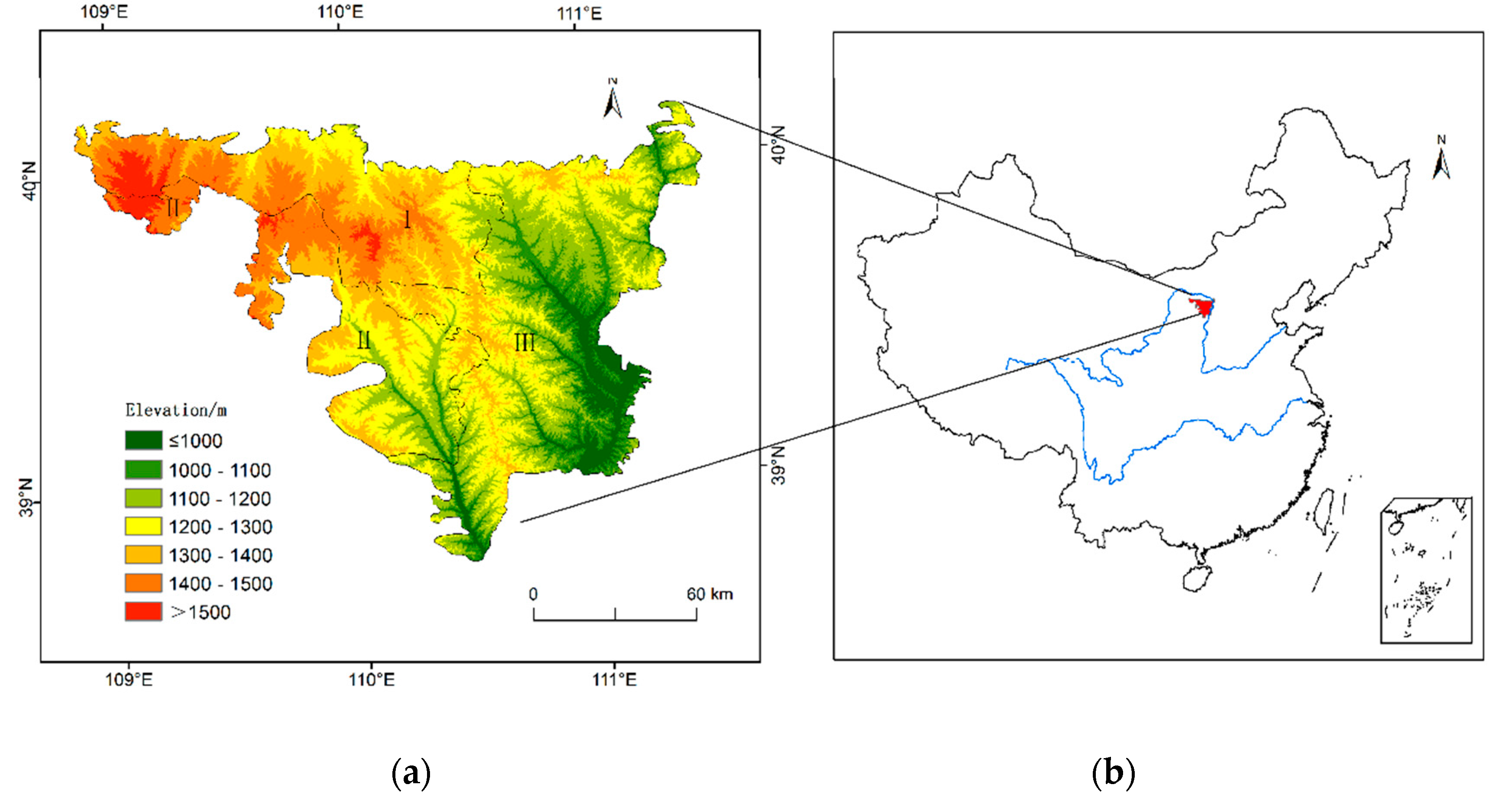

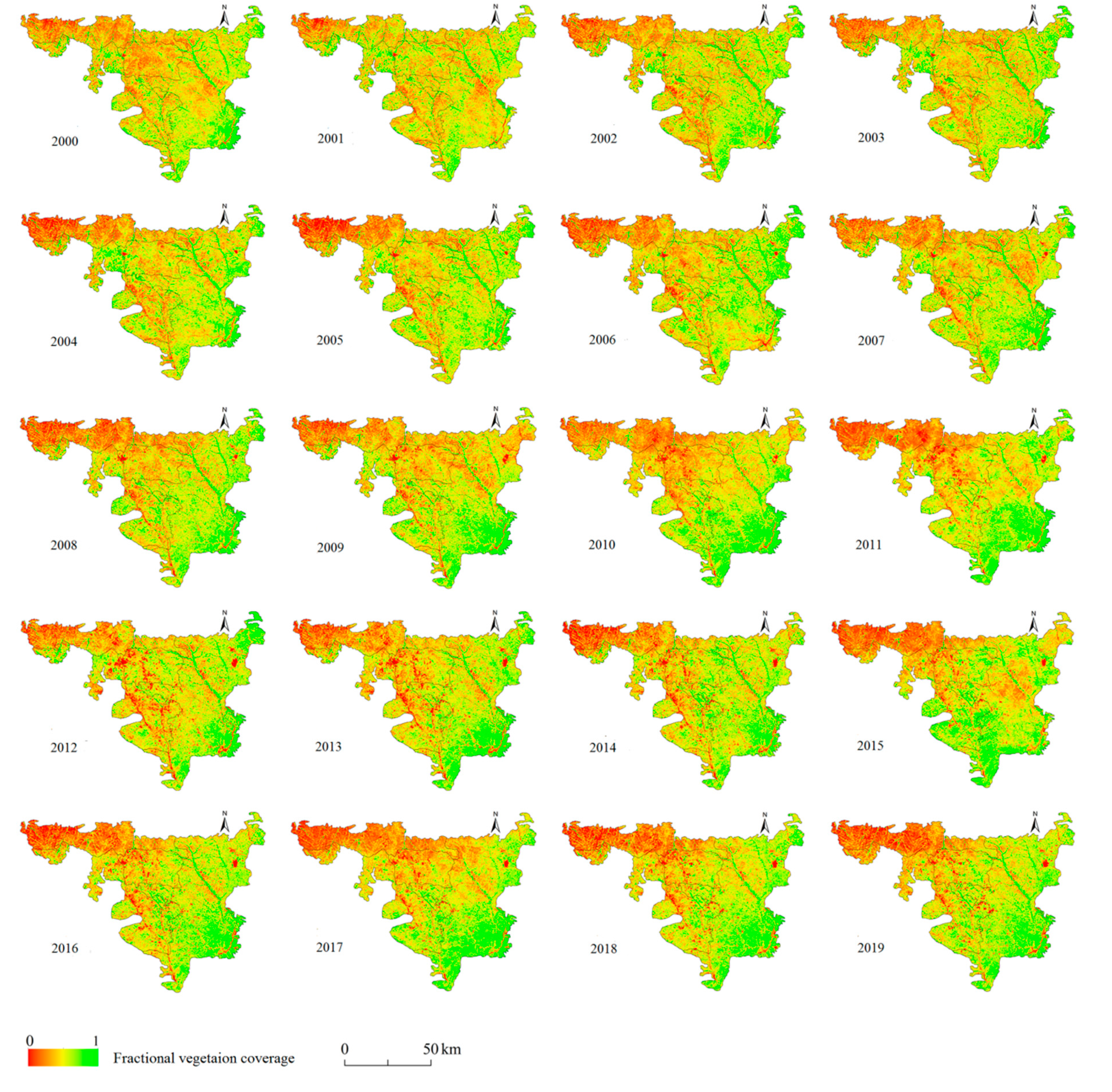
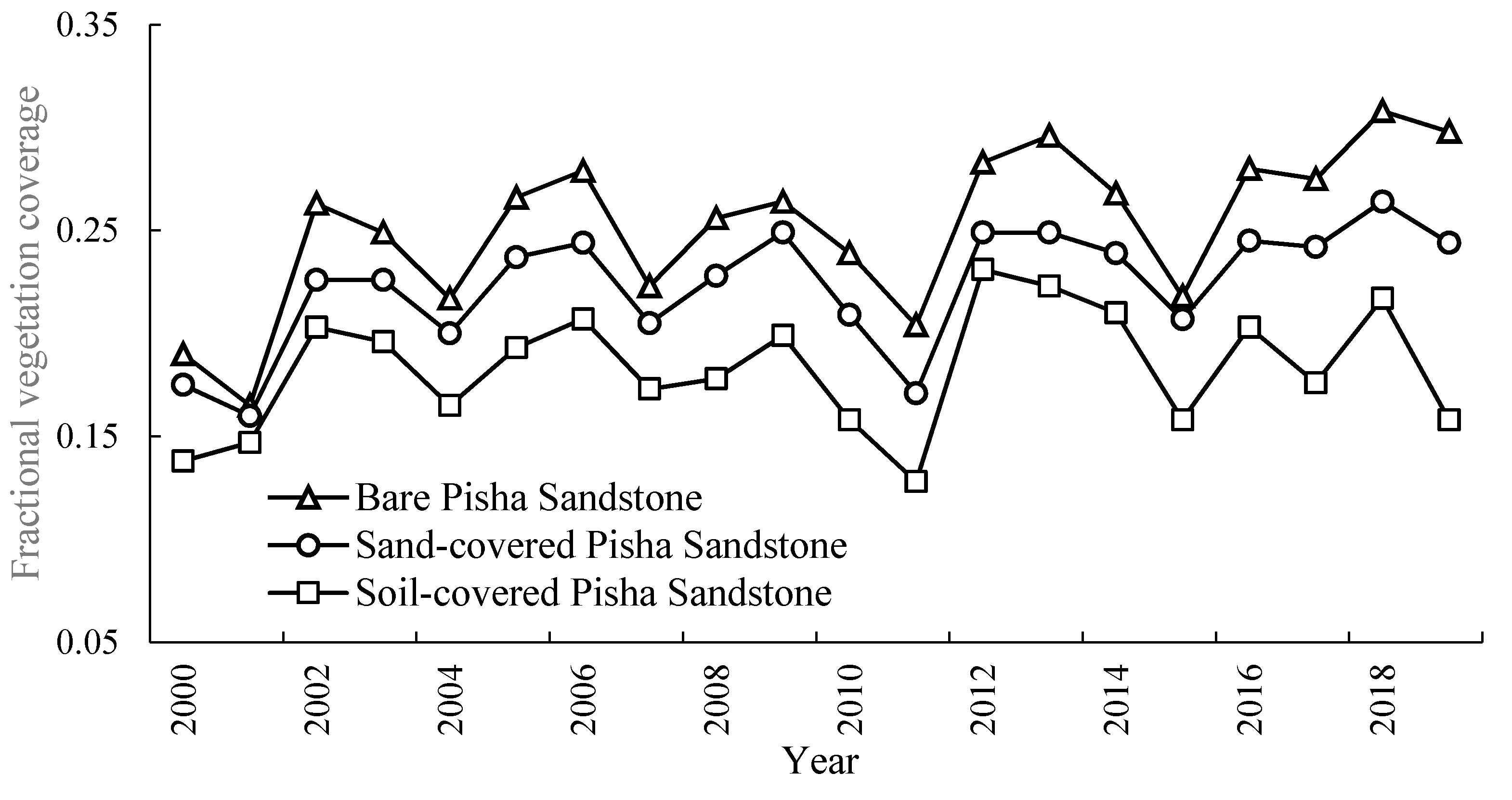


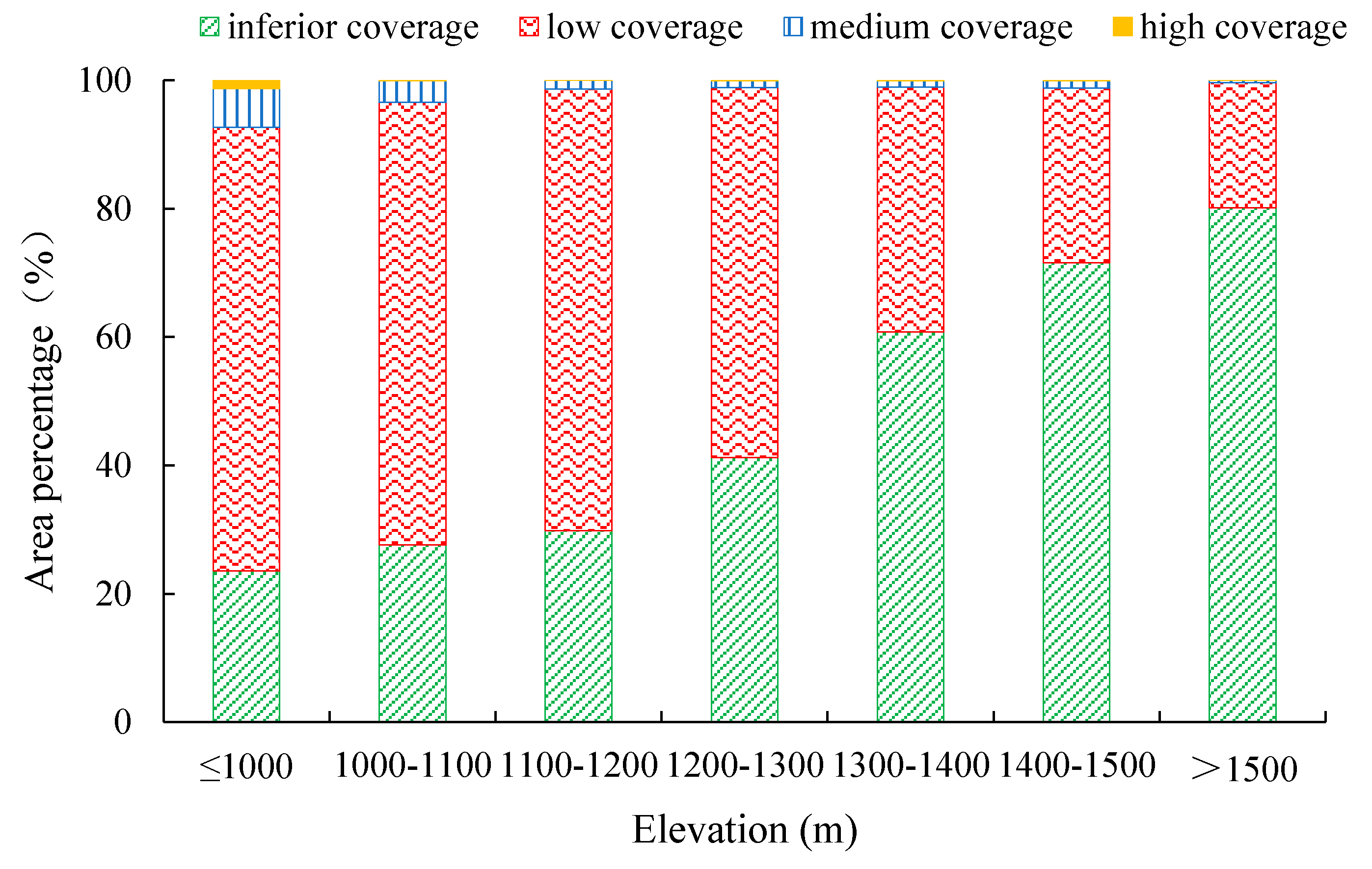


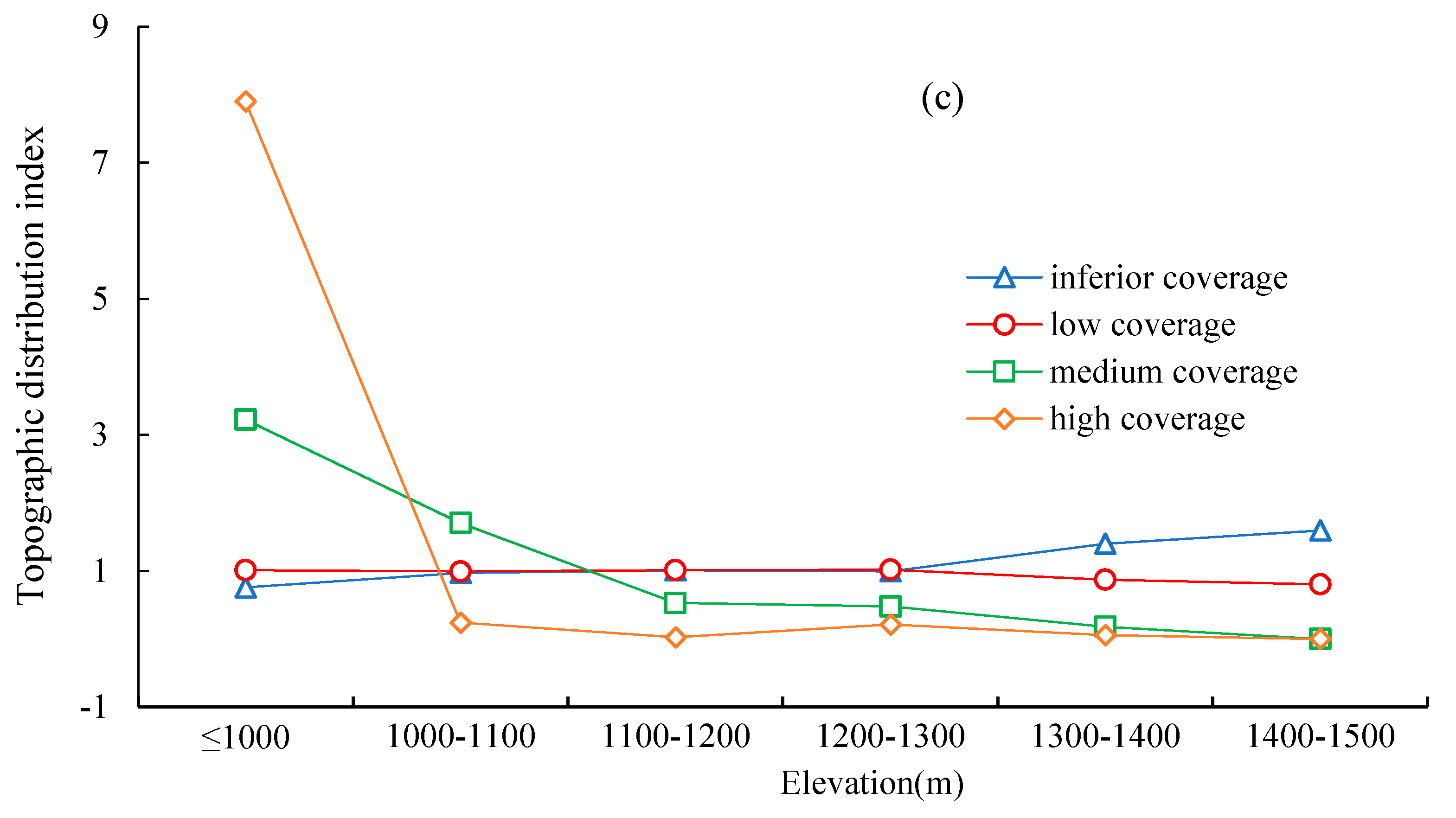

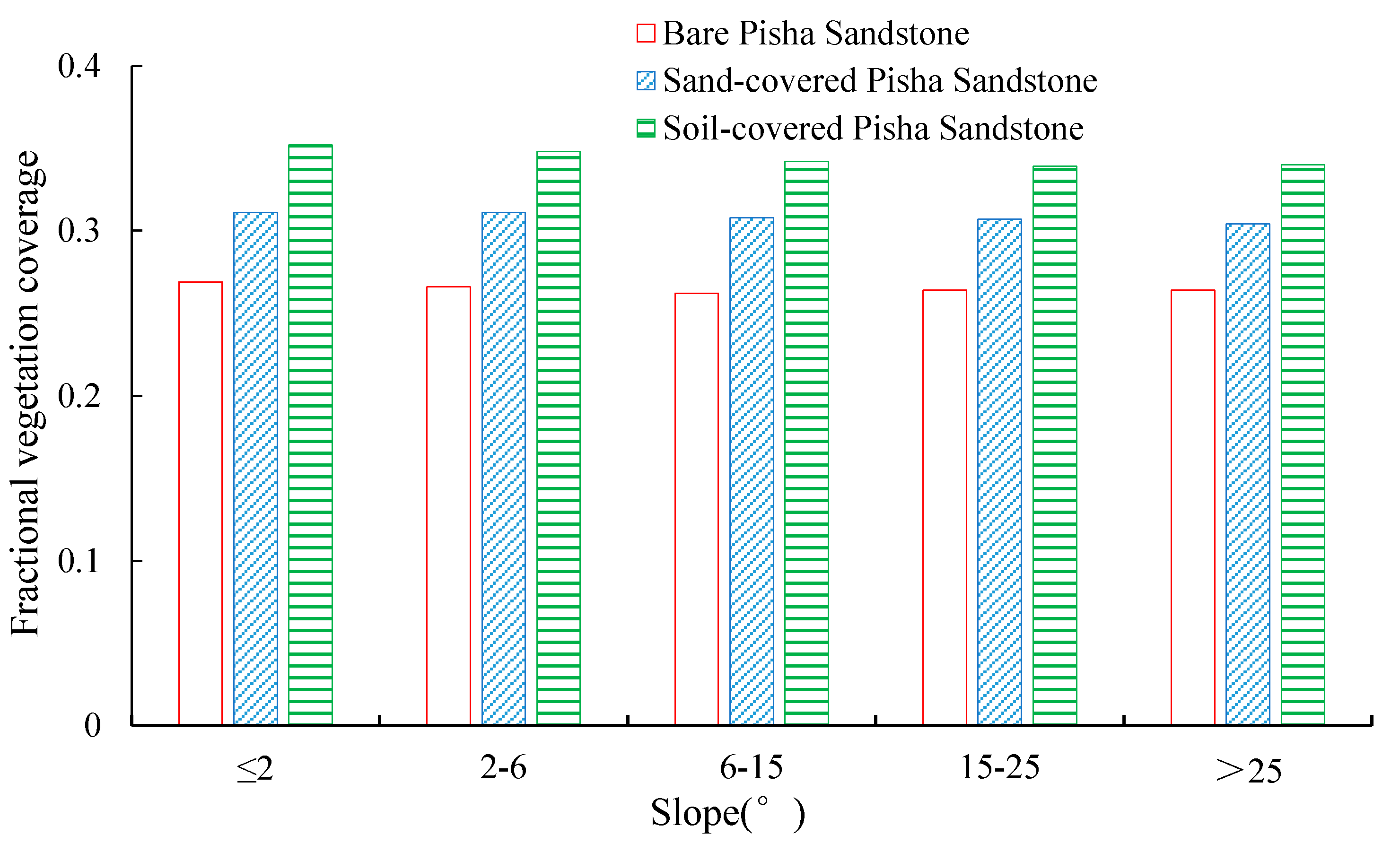
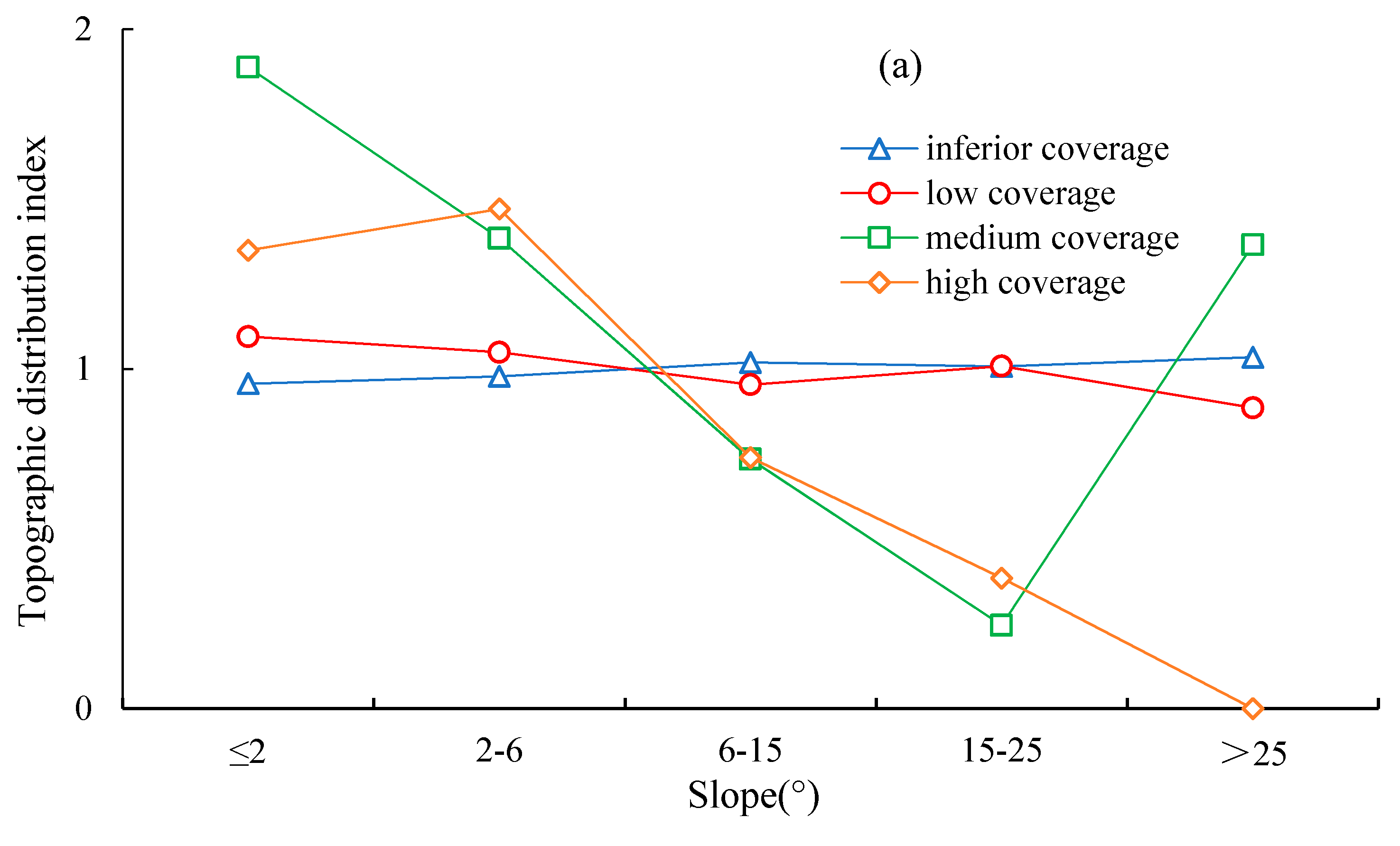

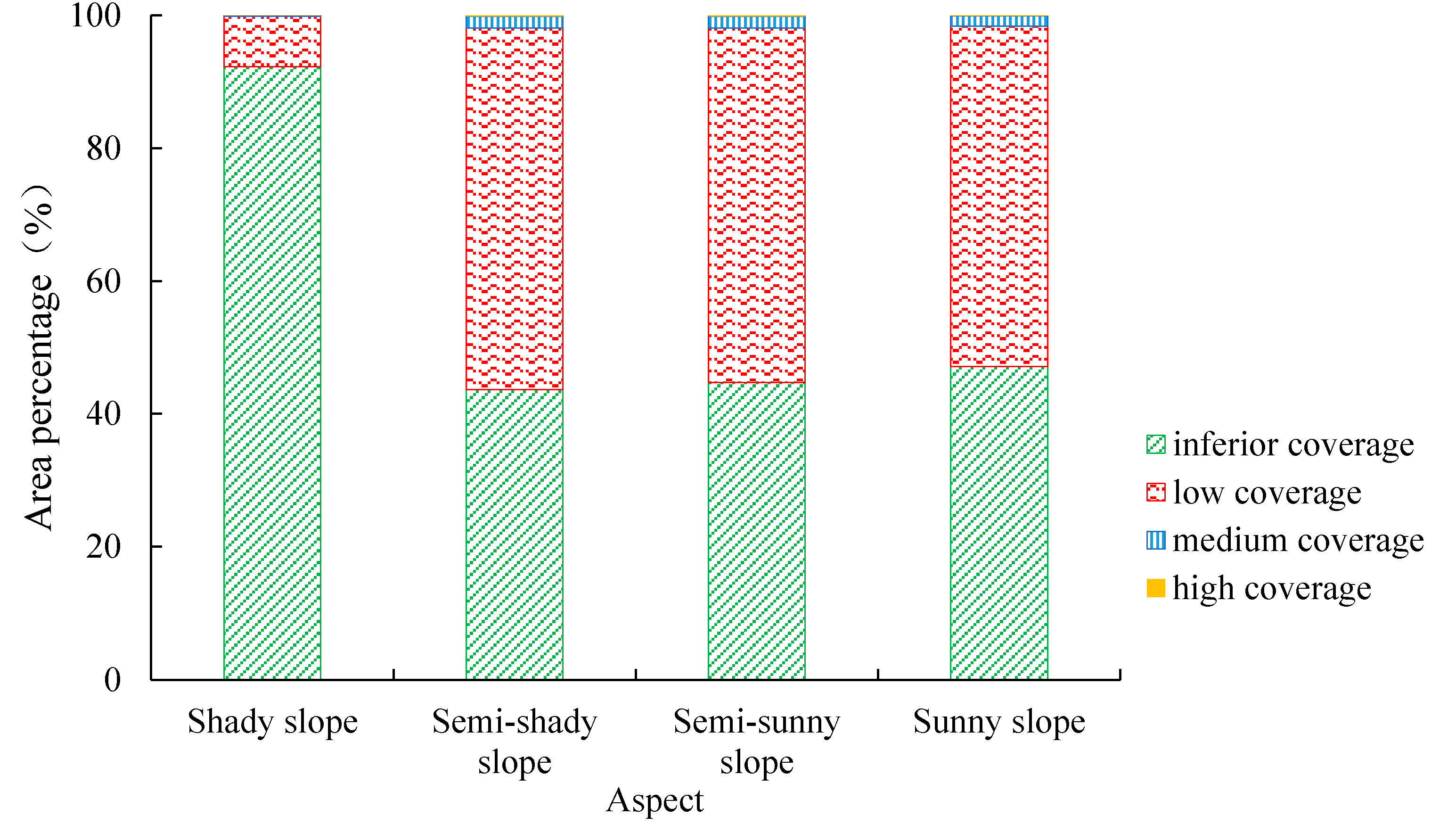
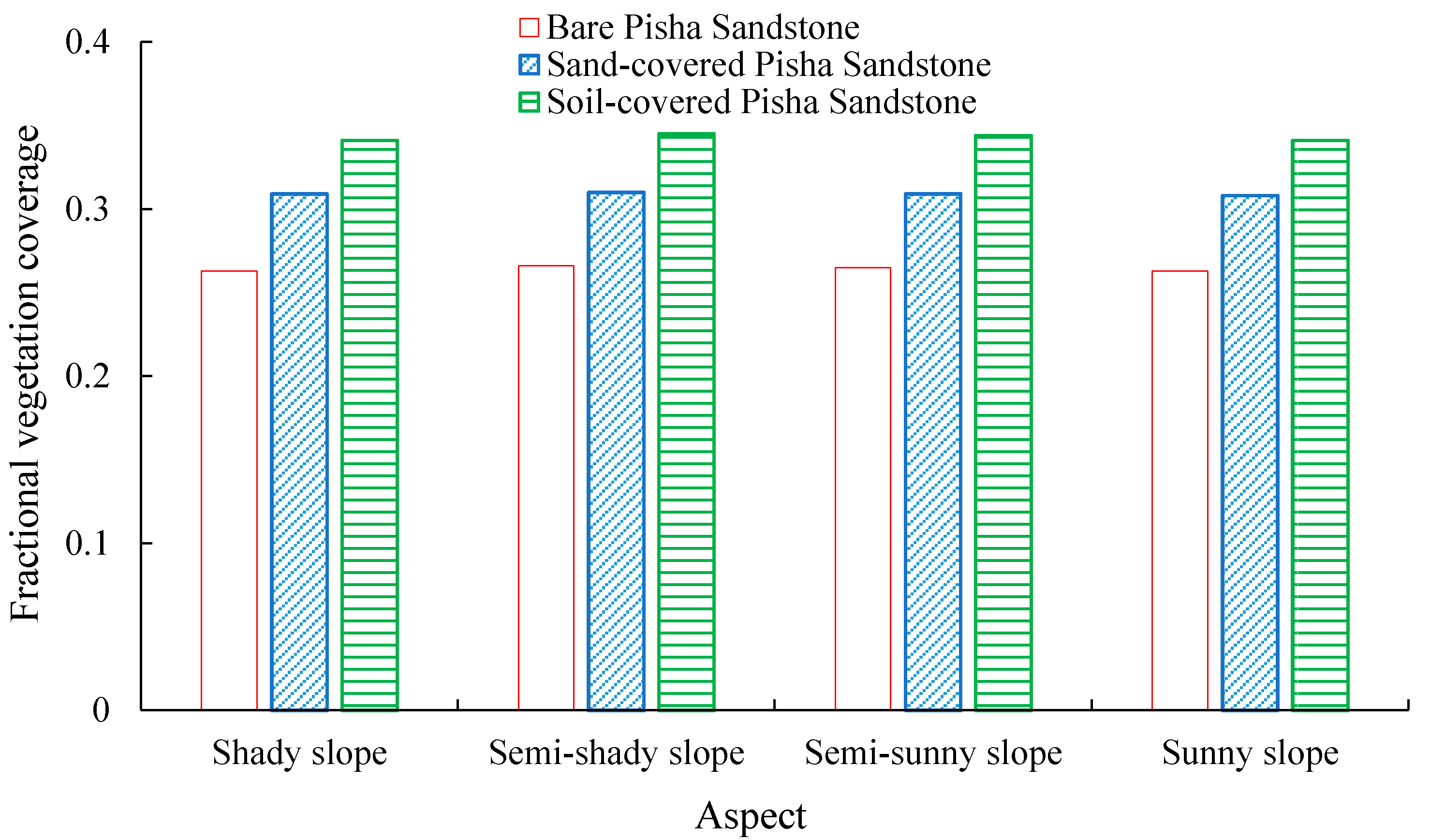
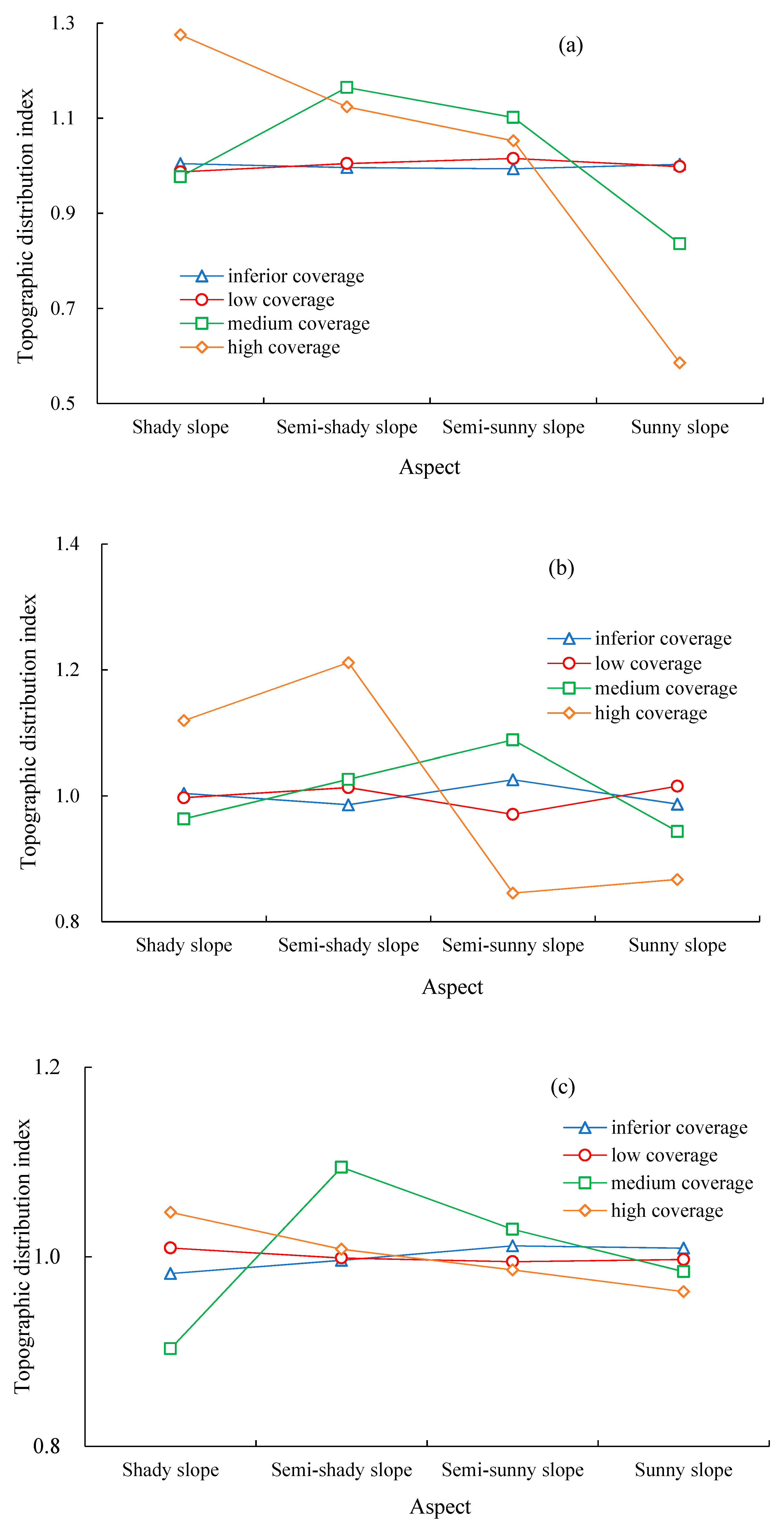
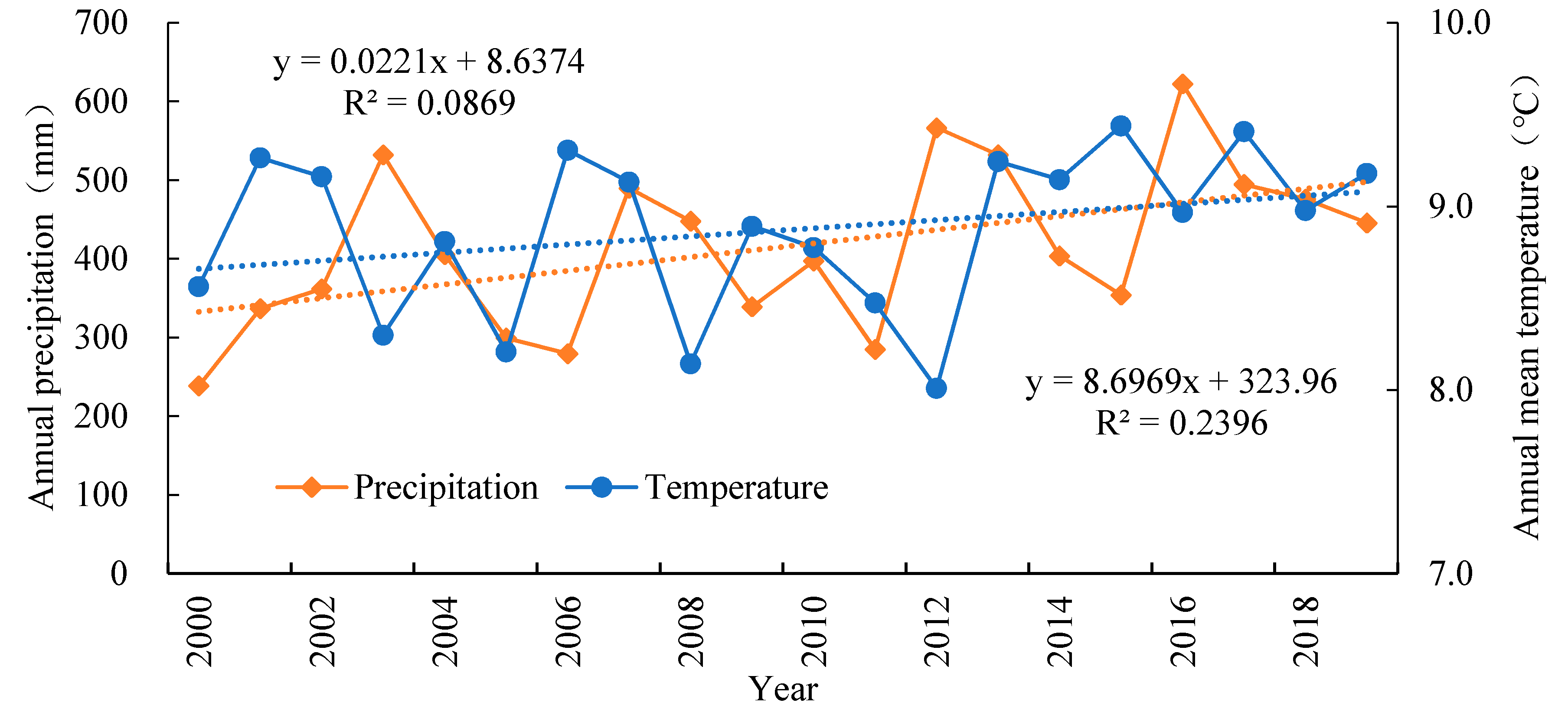
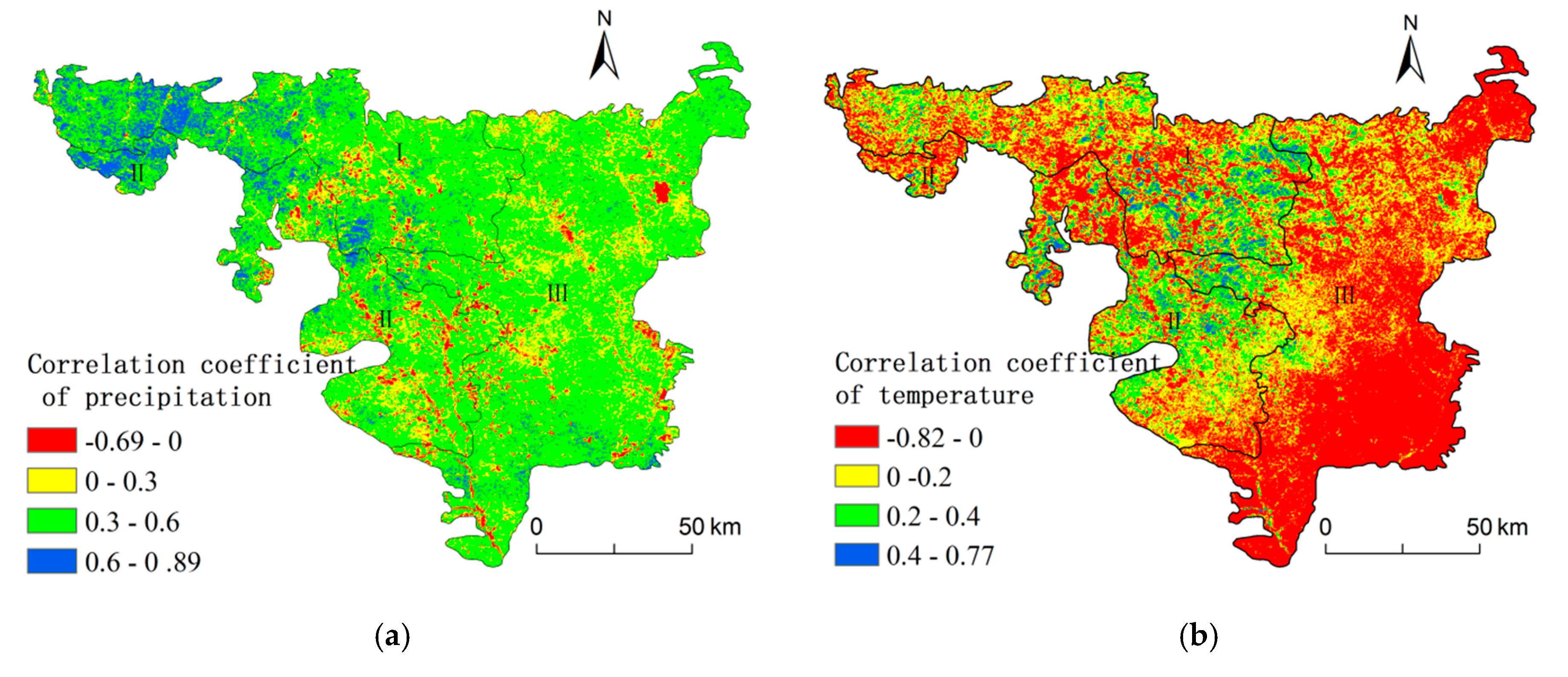
| Elevation | Fractional Vegetation Coverage | ||
|---|---|---|---|
| Slope ≤ 15° | 15° < Slope < 25° | Slope > 25° | |
| ≤1200 m | 0.254–0.373 | 0.250–0.365 | 0.244–0.359 |
| 1200–1300 m | 0.245–0.353 | 0.246–0.352 | 0.248–0.352 |
| >1300 m | 0.227–0.332 | 0.232–0.335 | 0.237–0.339 |
© 2020 by the authors. Licensee MDPI, Basel, Switzerland. This article is an open access article distributed under the terms and conditions of the Creative Commons Attribution (CC BY) license (http://creativecommons.org/licenses/by/4.0/).
Share and Cite
Wang, R.; Yan, F.; Wang, Y. Vegetation Growth Status and Topographic Effects in the Pisha Sandstone Area of China. Remote Sens. 2020, 12, 2759. https://doi.org/10.3390/rs12172759
Wang R, Yan F, Wang Y. Vegetation Growth Status and Topographic Effects in the Pisha Sandstone Area of China. Remote Sensing. 2020; 12(17):2759. https://doi.org/10.3390/rs12172759
Chicago/Turabian StyleWang, Ruijie, Feng Yan, and Yanjiao Wang. 2020. "Vegetation Growth Status and Topographic Effects in the Pisha Sandstone Area of China" Remote Sensing 12, no. 17: 2759. https://doi.org/10.3390/rs12172759





